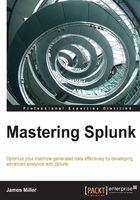
Confidentiality and security
Splunk uses a typical role-based security model to provide flexible and effective ways to protect all the data indexed by Splunk, by controlling the searches and results in the presentation layer.
More creative methods of implementing access control can also be employed, such as:
- Installing and configuring more than one instance of Splunk, where each is configured for only the data intended for an appropriate audience
- Separating indexes by Splunk role (privileged and public roles as a simple example)
- The use of Splunk apps such as configuring each app appropriately for a specific use, objective, or perhaps for a Splunk security role
More advanced methods of implementing access control are field encryptions, searching exclusion, and field aliasing to censored data. (You might want to research these topics independent of this book's discussions.)
The evolution of Splunk
The term big data is used to define information that is so large and complex that it becomes nearly impossible to process using traditional means. Because of the volume and/or unstructured nature of this data, making it useful or turning it into what the industry calls OI is very difficult.
According to the information provided by the International Data Corporation (IDC), unstructured data (generated by machines) might account for more than 90 percent of the data held by organizations today.
This type of data (usually found in massive and ever-growing volumes) chronicles an activity of some sort, a behavior, or a measurement of performance. Today, organizations are missing opportunities that big data can provide them since they are focused on structured data using traditional tools for business intelligence (BI) and data warehousing.
Mainstream methods such as relational or multidimensional databases used in an effort to understand an organization's big data are challenging at best.
Approaching big data solution development in this manner requires serious experience and usually results in the delivery of overly complex solutions that seldom allow enough flexibility to ask any questions or get answers to those questions in real time, which is not the requirement and not a nice-to-have feature.
The Splunk approach
"Splunk software provides a unified way to organize and to extract actionable insights from the massive amounts of machine data generated across diverse sources."
--www.Splunk.com 2014.
Splunk started with information technology (IT) monitoring servers, messaging queues, websites, and more. Now, Splunk is recognized for its innate ability to solve the specific challenges (and opportunities) of effectively organizing and managing enormous amounts of (virtually any kind) machine-generated big data.
What Splunk does, and does well, is to read all sorts (almost any type, even in real time) of data into what is referred to as Splunk's internal repository and add indexes, making it available for immediate analytical analysis and reporting. Users can then easily set up metrics and dashboards (using Splunk) that support basic business intelligence, analytics, and reporting on key performance indicators (KPIs), and use them to better understand their information and the environment.
Understanding this information requires the ability to quickly search through large amounts of data, sometimes in an unstructured or semi-unstructured way. Conventional query languages (such as SQL or MDX) do not provide the flexibility required for the effective searching of big data.
These query languages depend on schemas. A (database) schema is how the data is to be systematized or structured. This structure is based on the familiarity of the possible applications that will consume the data, the facts or type of information that will be loaded into the database, or the (identified) interests of the potential end users.
A NoSQL query approach method is used by Splunk that is reportedly based on the Unix command's pipelining concepts and does not involve or impose any predefined schema. Splunk's search processing language (SPL) encompasses Splunk's search commands (and their functions, arguments, and clauses).
Search commands tell Splunk what to do with the information retrieved from its indexed data. An example of some Splunk search commands include stats, abstract, accum, crawl, delta, and diff. (Note that there are many more search commands available in Splunk, and the Splunk documentation provides working examples of each!)
"You can point Splunk at anything because it doesn't impose a schema when you capture the data; it creates schemas on the fly as you run queries" explained Sanjay Meta, Splunk's senior director of product marketing.
--InformationWeek 1/11/2012.
The correlation of information
A Splunk search gives the user the ability to effortlessly recognize relationships and patterns in data and data sources based on the following factors:
- Time, proximity, and distance
- Transactions (single or a series)
- Subsearches (searches that actually take the results of one search and then use them as input or to affect other searches)
- Lookups to external data and data sources
- SQL-like joins
Flexible searching and correlating are not Splunk's only magic. Using Splunk, users can also rapidly construct reports and dashboards, and using visualizations (charts, histograms, trend lines, and so on), they can understand and leverage their data without the cost associated with the formal structuring or modeling of the data first.